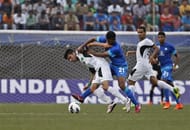The sensation that is the Hero Indian Super League is set to kick off in a week. And with Indian football being as low as it is now (India are currently ranked 158th in FIFA’s official rankings), there is only one direction it can go in, and that direction is certainly not further into the ground. Here are nine reasons why the ISL is the biggest thing to happen to Indian football:Disclaimer: Rome was not built in a day, so do not expect India to win the next FIFA World Cup. The below reasons have been listed farsightedly and not myopically.
#1 Development at the grassroots

Indian football is deficient on almost every front. Unsatisfactory infrastructure, inadequate financing, widespread insouciance, limited scope and a bevy of other deficiencies plague Indian football. But, above all, the sport's most patent deficiency lies in the grassroots. India has a virtually non-existent system of grassroots football. In fact, I'd even go so far as to say that the causa causans for Indian football being where it is- down in the dumps, is this lack of development of the sport at the grassroots level. And that is exactly what the Indian Super League aims to address.
The Indian Super League, for all its glamour, flamboyance and pizzazz, has been conceived with 'grassroots development' being its watchword. With AIFF Technical Director of Academies Scott O'Donell stating that the league's main objectives were 'to train at least a million kids' and 'to take the sport to every nook and corner of the country', camps have already been undertaken in re these objectives. Furthermore, all eight franchises have invested Rupees 2 crore each in nurturing the youth, setting up academies and scouring for talent.
While the fruit of these measures may not come to the fore immediately, they will, ineluctably, make for a future generation of Indians better acquainted and more inclined towards football.
While Rome may not have been built in a day, it was built, nonetheless. And so will Indian football.
#2 The Big Names

What good can possibly not come of a league that boasts the likes of Alessandro Del Piero, David Trezeguet, and Robert Pires? Seldom before have Indians had the opportunity to witness, let alone play alongside stars as decorated as these. Therefore, you know Indian football is looking up when you find out that these players and many more of their ilk are going to grace the country’s football league.
With each franchise snapping up a minimum of ten foreign players, most of who have played for, with and against the world’s finest, (and were also, during their heyday, among the world’s finest), their Indian counterparts will have to raise the bar in order to match them. And for a country where the football has never been of a particularly high pedigree, this is just the chance Indian footballers have been waiting for, to observe and absorb, firsthand.
Not to sound unrealistic, but the ISL could become a hub for foreign players, what with the money and the potential, if the inaugural edition does indeed prove to be a success.
A mini Barclays Premier League in the making, maybe?
#3 Unprecedented visibility and viewership

The ISL, in all its purview, has massive, never-seen-before visibility. With India’s entire footballing fraternity of 200+ million fans awaiting the league with bated breath, the sport will, for the first time, be widely watched domestically. This means that Indian players will, for the first time, have millions of eyes monitoring their every move. This is not something an Indian footballer is used to, with I-League turnouts lukewarm, at best. Mohun Bagan, which enjoyed the highest average turnout in the I-League last season saw only 17% of its stadium capacity filling up.
The Indian Super League, on the other hand, is expected to garner spectators in throngs, with many portending full houses. Television coverage too, is much broader, with a whopping 9 channels in India (beat that, cricket!) and Fox Sports telecasting the league abroad.
With much more coverage of the sport, players will gain the recognition they seek and deserve, for the first time in Indian football.
If that’s not good for Indian football, I don’t know what is.
#4 Marketing

What better way to sell something than have the country’s most popular figures not only endorse it, but take active part in it? That’s a sure shot success formula.
That is exactly what Reliance Industries and International Management Group have done to ensure that their 700-crore acquisition does not fizzle away, like every other indigenous football scheme the country has seen. While Ambani and co. certainly did not have a hand in recruiting the Tendulkars, Salmans, Ranbirs and Bacchans, they certainly made sure they created a league with the potential to do induce these superstars to do so. In acquiring (mostly as co-owners) these teams, these stars have given Indian football its much-needed impetus, in the form of glitz and glamour.
Now, even a football neutral or non-fan may end up following the league because of their favourite actors and cricketers. And football being the beautiful game it is, it wouldn’t be surprising if these non-fans get smitten by its charm. And football being the enticing game it is, there’s no coming back once you’re smitten by its charm. And that is what the ISL, with its all-out marketing strategy, has the potential to deliver.
#5 Money

Let’s face it. Football’s not the richest sport in India. From the AIFF’s dependency on a loan from the BCCI for promoting U-19 football to the I-League’s shortage of finacial puissance, Indian football is more like the pauper than the prince. But with the Indian Super League injecting funds into the sport, all this is set to change.
In terms of a set of mathematical equations and theses,
A football is round. (i.e., football = round)
Money makes the world go round. (i.e., money = world goes round)
Since football = round,
Money makes the world go football.
But,
Indian football = no money
Indian Super League = lots of money
Therefore,
Indian football with Indian Super League = money
Therefore, money makes India go football.
So, India, let’s football.
#6 European tie-ups

“We will play the Fiorentina way”- said Parmesh Naik, development manager, FC Pune City.
“Atletico de Kolkata will try to adopt the Atletico Madrid philosophy.”- said Miguel Martinez, assistant coach, Atletico de Kolkata.
If the franchises do indeed team up with European heavyweights like Atletico Madrid, Inter Milan and Fiorentina, all parties involved will be benefited. The All India Football Federation, which has come under the scanner for the lack of professionalism of the I-League, will assume a new, professional face with the Indian Super League, partnering the English Premier League; managers will acquaint themselves with coaching nuances and regimes (such as dietary habits), players will imbibe proven techniques, assimilate invaluable knowledge and incorporate some of the most efficient brands of football currently in their game.
In short, the Indian Super League’s European tie-ups will engender Indian football in a win-win-win situation.
Also, commercially, this could open up infinite avenues in the way of sponsorships, endorsements and permanent collaborations. From win-win-win to win-win-win-win.

#7 It worked with the MLS

For a country where football does not refer to football, USA have a surprisingly good football (and I mean football) team, much thanks to the Major League Soccer. The MLS, that has revolutionised football in America, was, at its inception, a large-scale miscarriage. But that was before The Beckham Experiment . The arrival of a man as mercurial as Beckham changed the entire complexion of the MLS as the MLS Commissioner Don Garber admitted.
The turning point of the MLS, therefore, was the arrival of a star the stature of David Beckham, who became not only the face of LA Galaxy, but a symbol of the sport itself.
That star-quotient is exactly what the Indian Super League is banking on. While it may not have a Beckham yet, a Del Piero or a Materazzi isn’t too shabby either. If the current stars of the ISL recreate even a fraction of what Beckham produced in America, Indian football is bound to improve by leaps and bounds.
In fact, the success of the MLS is what the Indian Super League is banking on. From the competition format to the non-promotion, non-relegation system, the ISL is almost a facsimile of the MLS. Now, if only Indian football can become a facsimile of American football (and I mean soccer).
#8 International Fixtures

India may not boast the best national team, but that’s no justification for just three friendlies this calendar year. Whether this reflects poor planning on the part of FIFA or the fact that the World Cup took place this year, one international game every hundred and twenty two days does not bode well for team building, chemistry and improvement. For an aspiring team, such infrequent playing is downright unacceptable.
While the working of the FIFA and the scheduling of the World Cup is not within the control of Indian football, it has done the next best thing and created a league hosting some of the world’s better-known players over the last decade. This offsets the lack of international friendlies as players get to play high-quality football while not on international duty.
Also, India’s international friendlies over the last couple of years have been against Afghanistan, Tajikistan, Chinese Taipei, Nepal, Guam, Pakistan and Maldives, which in all honesty, aren’t the most threatening oppositions. The ISL, on the other hand contains World Cup and Champions League winners.
Who needs poorly-planned, unappetizing international friendlies when you have the star-studded ISL?
#9 Bye-bye Cricket?
It seems ironic that Sachin Tendulkar, Sourav Ganguly and Virat Kohli are advocating their own sport’s undoing.
Any football fan in the country would blame the country’s cricket obsession for football being given the cold shoulder, and whether or not its just sour grapes, there is a kernel of truth in it. One of life’s most elementary laws is the ‘survival of the fittest’ law. Be it in the case of plants, Harry Potter and Voldemort or sport in this case, this law holds good without exception. And football has languished in India, while cricket has flourished.
With cricket witnessing burnout across the country, football has licked its wounds and is waiting to pounce. The ISL could not have arrived at a better time, with cricket being at its most vulnerable. Football has found its hammer in the Hero Indian Super League and is preparing to strike the iron while its still hot. No longer will football wait on the sidelines. No longer will football be the neglected son. No longer will football play second fiddle to cricket, for its time is now.
Will football wield its ISL-hammer and deliver a knockout blow to cricket? Or will cricket provide resilient resilience? For this and much more, tune in to the Hero Indian Super League come twelfth October.
